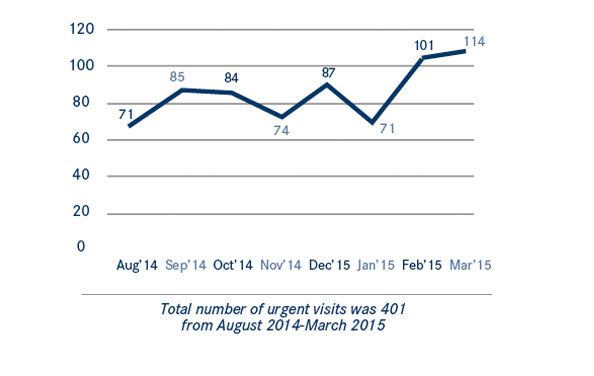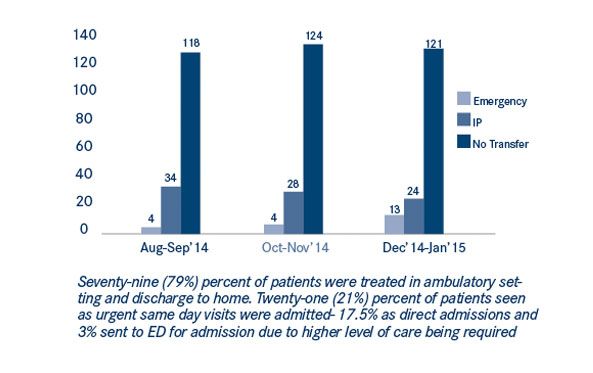Urgent Visit Program Aims to Reduce ED Admissions
Educating, raising awareness, and implementing an urgent visit program can reduce emergency department use and number of hospitalizations.
Vanna M. Dest, MSN, APRN, BC, AOCN

Vanna M. Dest, MSN, APRN, BC, AOCN
In the United States, 30% of the total cancer expenditure is spent in the last year of the life, and 55% of this is spent on inpatient care. For patients with advanced cancer, most hospitalizations arise from expected disease progression. Smilow Cancer Hospital at Yale New Haven is a 15 story, 500,000 square foot facility affiliated with Yale-New Haven Hospital and Yale Cancer Center. It incorporates ambulatory and inpatient services as well as radiation therapy services, infusion centers, women’s services, radiology, surgical suites, cancer survivorship, and complementary services.
We examined preventable emergency department (ED) admissions during daytime hours. We reviewed oncology ED data over a 5-month period from January 1 through May 31, 2014. A total of 391 patients presented to the ED, and approximately 90% of those patients were admitted. Sixty-two percent of patients arrived to the ED between the hours of 9:00 AM and 5:00 PM, and average length of stay was 6.74 days.
Most hospitalizations resulted from expected disease progression. The five most common admitting diagnoses included: (1) fever/neutropenic fever/sepsis; (2) abdominal pain; (3) altered mental status; (4) dehydration/electrolyte imbalance; and (5) pneumonia/dyspnea. Chart review demonstrated many patients could have been managed in the ambulatory setting with pharmacy, infusion, and palliative care support.
Implementing an Urgent Visit Program
A task force was formed to determine current practices among disease teams and included practice nurses, nurse coordinators, and advanced practice providers (APPs) from solid tumor and hematology disease teams. The task force established guidelines to reduce the number of cancer patients seen in the ED by being evaluated by a skilled clinician in an urgent visit program.
Table 1: Urgent Care Visits by Month
Table 1: Urgent Care Visits by Month

Source: Yale-New Haven Hospital Joint Data Analysis Team (JDAT); refreshed baseline and post-intervention data with new oncology service line definition.
It is crucial that the same day/urgent visit program have access to urgent palliative care consultation, pharmacy, and infusion chairs. As patient calls come into disease teams, any urgent issues are expedited to a practice nurse and/or APP. The decision is then made whether the patient is appropriate for an urgent clinic visit or ED.
Medical situations which warranted direct assessment in ED and 911 included: (1) loss of consciousness; unresponsiveness; (2) sudden, acute onset of dyspnea/cyanosis; (3) acute chest pain; (4) uncontrollable bleeding/hypovolemic; and (5) unstable, based upon telephone assessment by APP. Urgent visit hours were established between the hours of 7:30 AM and 3:30 PM. Education was pivotal, and appropriate training was provided to patients and their caregivers, intake/clinical secretaries, nursing staff, and other providers, which included physicians, APPs, and oncology fellows. In order to capture urgent visits, we developed a visit type in the electronic medical record called Priority Visit. We implemented our APP Urgent Visit program on July 31, 2014.
Program Results
We analyzed data after 6 months. Table 1 shows the number of APP urgent visits increased since implementation of program. We found that oncology ED visits decreased from 88.2% to 83.9%. Notably, 79% of patients seen as priority visits were treated in the ambulatory setting and discharged to home; 18% of patients were seen as urgent/priority visits and after evaluation by APP, it was decided they needed to be admitted through direct admission process; and 3% needed a higher level of care and were transferred to the ED (Table 2). This is compared with almost 90% of patients who present to ED first and get hospitalized.
Table 2: Urgent Care Visit Dispositions/Transfers
Table 2: Urgent Care Visit Dispositions/Transfers

Source: Yale-New Haven Hospital Joint Data Analysis Team (JDAT); refreshed baseline and post-intervention data with new oncology service line definition.
The initial 6-month evaluation of the urgent visit program shows promise. As demonstrated, educating, raising awareness, and implementing an urgent visit program can reduce ED use and number of hospitalizations. Ongoing education and reinforcement are needed to reinforce the value of the urgent visit program. To sustain and further decrease the number of patients presenting to the ED, an urgent care program requires a high level of committed and skilled personnel, as well as space, and the establishment of a designated urgent care unit is at Smilow Cancer Hospital is currently being evaluated.

Innovative Program Reduces Nurse Turnover and Fosters Development
Published: September 12th 2024 | Updated: September 12th 2024The US Oncology Network (The Network) has developed one of the most comprehensive programs in the nation to support the professional development and retention of new oncology nurses.




